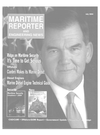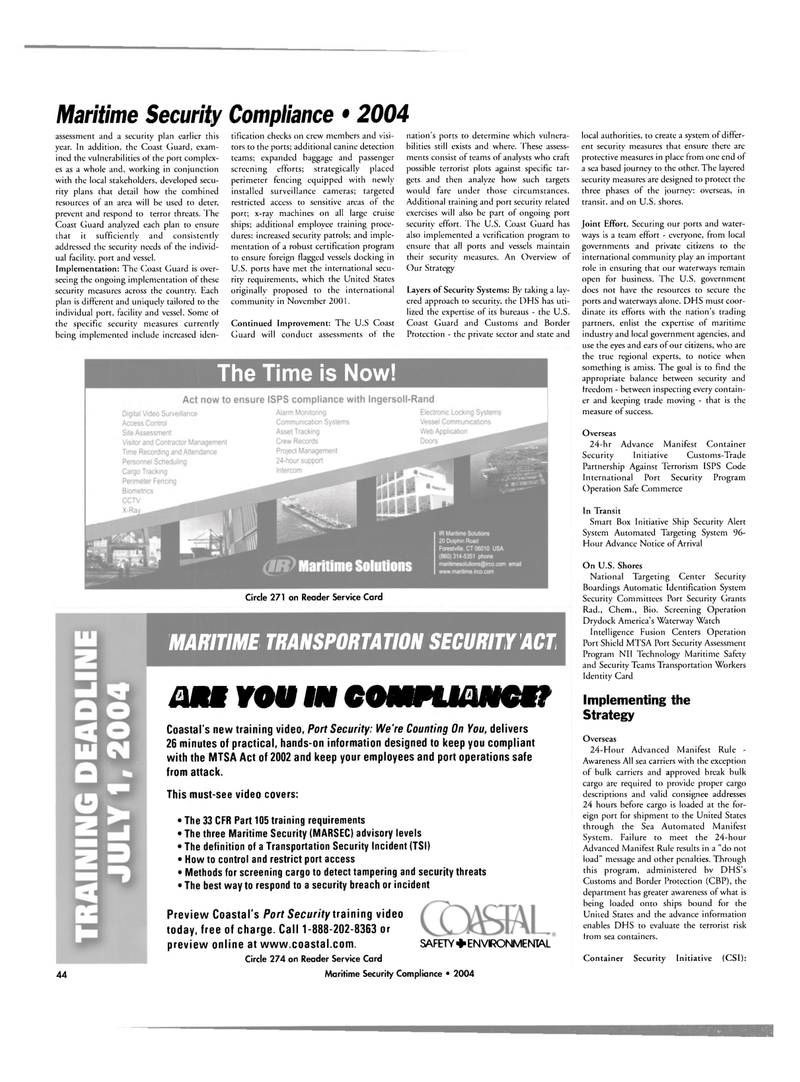
Page 44: of Maritime Reporter Magazine (July 2004)
Gulf of Mexico: Floating Production Systems & Support Vessels
Read this page in Pdf, Flash or Html5 edition of July 2004 Maritime Reporter Magazine
Maritime Security Compliance • 2004 assessment and a security plan earlier this year. In addition, the Coast Guard, exam- ined the vulnerabilities of the port complex- es as a whole and, working in conjunction with the local stakeholders, developed secu- rity plans that detail how the combined resources of an area will be used to deter, prevent and respond to terror threats. 1 he
Coast Guard analyzed each plan to ensure that it sufficiently and consistently addressed the security needs of the individ- ual facility, port and vessel.
Implementation: The Coast Guard is over- seeing the ongoing implementation of these security measures across the country. Each plan is different and uniquely tailored to the individual port, facility and vessel. Some of the specific security measures currently being implemented include increased iden- tification checks on crew members and visi- tors to the ports; additional canine detection teams; expanded baggage and passenger screening efforts; strategically placed perimeter fencing equipped with newly installed surveillance cameras; targeted restricted access to sensitive areas of the port; x-ray machines on all large cruise ships; additional employee training proce- dures: increased security patrols; and imple- mentation of a robust certification program to ensure foreign flagged vessels docking in
U.S. ports have met the international secu- rity requirements, which the United States originally proposed to the international community in November 2001.
Continued Improvement: The U.S Coast
Guard will conduct assessments of the nation's ports to determine which vulnera- bilities still exists and where. These assess- ments consist of teams of analysts who craft possible terrorist plots against specific tar- gets and then analyze how such targets would fare under those circumstances.
Additional training and port security related exercises will also be part of ongoing port security effort. The U.S. Coast Guard has also implemented a verification program to ensure that all ports and vessels maintain their security measures. An Overview of
Our Strategy
Layers of Security Systems: By taking a lay- ered approach to security, the DHS has uti- lized the expertise of its bureaus - the U.S.
Coast Guard and Customs and Border
Protection - the private sector and state and
The Time is Now!
Circle 271 on Reader Service Card
MARITIME TRANSPORTATION SECURITY ACT miff ran m gommmmw
Coastal's new training video, Port Security: We're Counting On You, delivers 26 minutes of practical, hands-on information designed to keep you compliant with the MTSA Act of 2002 and keep your employees and port operations safe from attack.
This must-see video covers: • The 33 CFR Part 105 training requirements • The three Maritime Security (MARSEC) advisory levels • The definition of a Transportation Security Incident (TSI) • How to control and restrict port access • Methods for screening cargo to detect tampering and security threats • The best way to respond to a security breach or incident
Preview Coastal's Port Security training video today, free of charge. Call 1-888-202-8363 or preview online at www.coastal.com.
Circle 274 on Reader Service Card
SAFETY + ENVIRONMENTAL local authorities, to create a system of differ- ent security measures that ensure there are protective measures in place from one end of a sea based journey to the other. The layered security measures are designed to protect the three phases of the journey: overseas, in transit, and on U.S. shores.
Joint Effort. Securing our ports and water- ways is a team effort - everyone, from local governments and private citizens to the international community play an important role in ensuring that our waterways remain open for business. The U.S. government does not have the resources to secure the ports and waterways alone. DHS must coor- dinate its efforts with the nation's trading partners, enlist the expertise of maritime industry and local government agencies, and use the eyes and ears of our citizens, who are the true regional experts, to notice when something is amiss. The goal is to find the appropriate balance between security and freedom - between inspecting every contain- er and keeping trade moving - that is the measure of success.
Overseas 24-hr Advance Manifest Container
Security Initiative Customs-Trade
Partnership Against Terrorism ISPS Code
International Port Security Program
Operation Safe Commerce
In Transit
Smart Box Initiative Ship Security Alert
System Automated Targeting System 96-
Hour Advance Notice of Arrival
On U.S. Shores
National Targeting Center Security
Boardings Automatic Identification System
Security Committees Port Security Grants
Rad., Chem., Bio. Screening Operation
Drydock America's Waterway Watch
Intelligence Fusion Centers Operation
Port Shield MTSA Port Security Assessment
Program Nil Technology Maritime Safety and Security Teams Transportation Workers
Identity Card
Implementing the
Strategy
Overseas 24-Hour Advanced Manifest Rule -
Awareness All sea carriers with the exception of bulk carriers and approved break bulk cargo are required to provide proper cargo descriptions and valid consignee addresses 24 hours before cargo is loaded at the for- eign port for shipment to the United States through the Sea Automated Manifest
System. Failure to meet the 24-hour
Advanced Manifest Rule results in a "do not load" message and other penalties. Through this program, administered bv DHS's
Customs and Border Protection (CBP), the department has greater awareness of what is being loaded onto ships bound for the
United States and the advance information enables DHS to evaluate the terrorist risk trom sea containers.
Container Security Initiative (CSI): 44 Maritime Security Compliance • 2004

 43
43

 45
45
